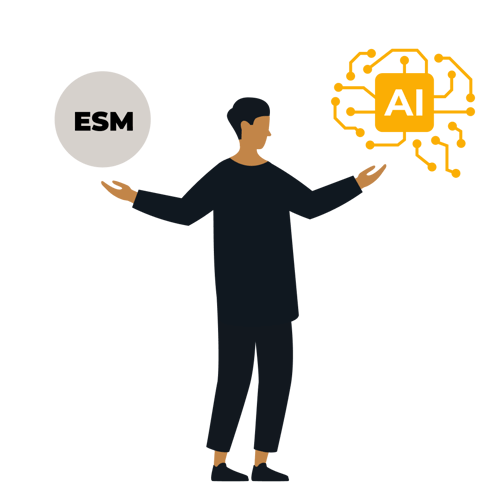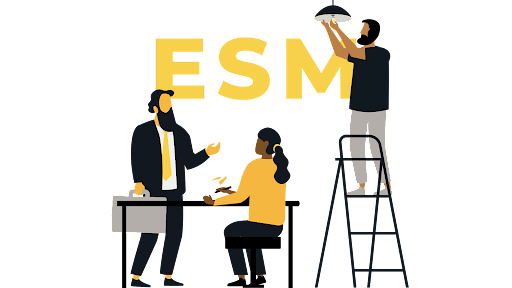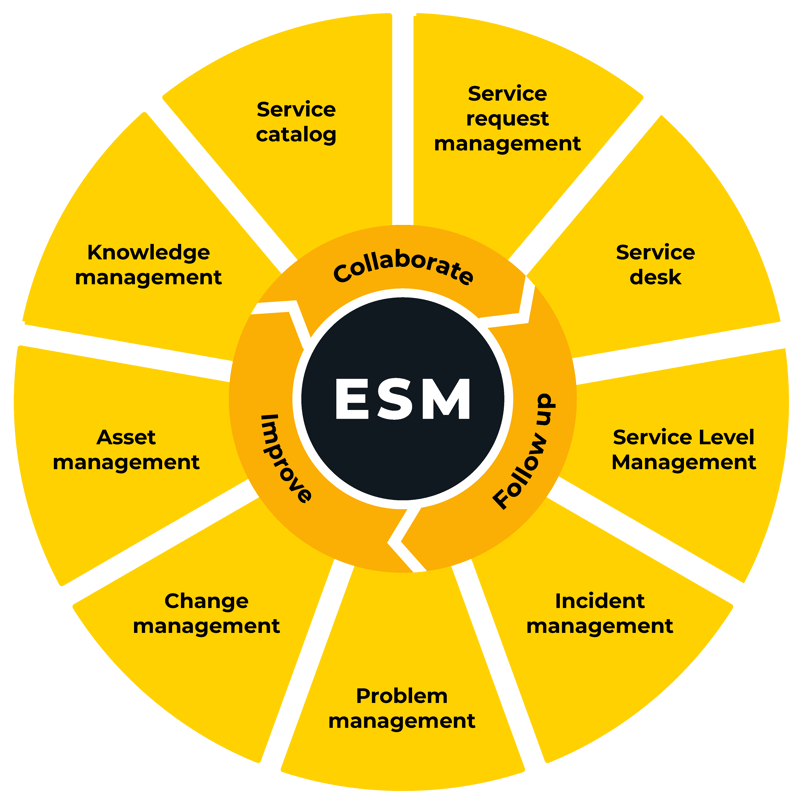Between 2020 and 2027, the projected growth rate for the service management solutions and services sector is a robust 18.2%. Fortune Business Insights
If you work in a service team, such as HR, facilities, finance, or marketing, chances are you’ve adopted ITSM software to help you tackle your workload, and why wouldn’t you, given the service request, problem, and change management capabilities of these applications?
Although useful on the surface, they’re likely making your work more complex, as software made for IT teams will have functions and processes irrelevant to your department.
Enterprise Service Management (ESM) is the alternative solution that extends beyond the principles and practices of ITSM to meet the needs of various departments, aligning them with business goals.
It's not a case of Enterprise Service Management vs. ITSM; ESM not only comes from it but the frameworks can be used together, as you'll learn by reading on.
Part 1
What is Enterprise Service Management?
ESM focuses on applying service-oriented practices, business processes, and tools to improve service delivery, efficiency, and collaboration across various functions and departments.
Solutions help streamline workflows, enhance communication, and align your services with business goals, ultimately driving better outcomes and experiences for you, your colleagues, and your customers.
In Enterprise Service Management, market size acts as a measure of the effectiveness of solutions in addressing business needs and driving productivity gains.
Enterprise Service Management principles
Upon approaching service management, it's important to understand the principles that can help you navigate and contribute to a service-oriented culture.
- Service orientation: ESM adopts a service-oriented approach, focusing on delivering value to your internal and external customers through defined services.
- Integration: ESM emphasizes integrating various business functions and processes to streamline your operations and improve efficiency. Reduced costs often come from this.
- Customer focus: ESM prioritizes the needs and expectations of your customers, both internal and external, by aligning services with their wants.
- Standardization: ESM aims to standardize your processes and procedures across the organization to ensure consistency and reliability in your service delivery.
- Continuous improvement: ESM promotes a culture of continuous improvement, where processes, services, and workflows are regularly reviewed and enhanced to drive efficiency and effectiveness.
- Collaboration: ESM encourages collaboration among different departments and teams to optimize resources, share knowledge, and solve problems.
- Automation: ESM leverages automation tools and technologies to automate routine tasks, reduce manual effort, and increase productivity.
- Governance: ESM establishes governance frameworks to ensure that the services you deliver are in line with your business policies, regulations, and standards.
- Measurement and metrics: ESM relies on performance metrics and key performance indicators (KPIs) to monitor the effectiveness of your services and identify areas for improvement.
- Flexibility and scalability: ESM tools are designed to be flexible and scalable, allowing your business to adapt to changing needs and scale accordingly.
What ESM is made up of
Service catalog
Is your central repository for accessing and requesting services to support your work. By effectively managing the service catalog within an ESM framework, you can streamline service delivery, improve user satisfaction, and enhance operational efficiency across departments.
Service request management
Involves handling and fulfilling requests from users efficiently within an organization with the end goal of improving customer satisfaction. It includes receiving requests, categorizing them, automating workflows, fulfilling requests, communicating with requesters, and tracking progress.
Service desks
An ESM service desk extends its support beyond IT to address a broader range of requests from various departments. These include HR for questions about company policies, onboarding, etc., finance for expense approvals, budget queries, reimbursements, and so on, and marketing for collateral requests, campaign tracking, and the like.
Service desk tools habitually incorporate most of the ITIL processes, including capacity management.
Service Level Management (SLM)
Focuses on defining, negotiating, and managing service level agreements (SLAs) between service providers and customers departmentally. These SLAs establish clear expectations, responsibilities, and performance targets for the delivery of services, regardless of whether they are IT-related or not.
Incident management
When issues are reported, detailed records are kept to help you decide which ones need urgent attention. Users are kept updated on the progress of fixing issues; after an issue is resolved, you can look into why it happened and prevent it from reoccurring.
Problem management
Centers around identifying and addressing the root cause of issues within your organization. Through effective problem management, ESM empowers you to enhance service reliability, minimize disruptions, and optimize operational efficiency holistically.
Change management
Is all about transparency and collaboration among your stakeholders. It involves change request submission processes and assessments around the impact of changes business-wide. Considerations span risks, benefits, resource needs, and alignment with overarching objectives.
Asset management
Varies depending on your department. In Enterprise Service Management, examples include office furniture, machinery, vehicles, facilities, equipment, and resources that support business operations.
Knowledge management
Involves gathering, organizing, and sharing information and insights across your business. For example, if you're in marketing, collateral such as brand guidelines, brochures, and campaign focuses can be stored and shared company-wide as they often contain information about your brand's identity, products or services, target audience, etc.
In summary, ESM is all about facilitating the right processes, tools, and workflows for highly productive organizations and where departments work well together. It pushes you to have an enterprise-wide focus where you need to integrate with your existing systems and reuse what you have (if it benefits the business).
Part 2
What Enterprise Service Management isn’t
ESM isn't just about IT
ITSM and ESM are not the same thing. ITSM mostly benefits IT teams, whereas with Enterprise Service Management, companies can address challenges across departments, e.g., HR, finance, facilities, customer service, and so on.
ESM isn't solely about technology
Although technology plays a significant role in supporting ESM initiatives through service management tools, i.e., service desks, it’s fundamentally about improving service delivery and operational efficiency across the enterprise. It involves aligning people, processes, and technology to deliver value to internal and external customers.
ESM isn't a one-size-fits-all solution
There's no single Enterprise Service Management framework or methodology that suits all organizations. It requires customization and adaptation to specific needs, as every organization has its own challenges and goals.
ESM isn't just about efficiency
While improving operational efficiency is a common objective, it's not the sole focus. ESM aims to enhance service quality, customer experiences, and business outcomes. It involves fostering a culture of continuous improvement and innovation to meet the growth of your business and the expectations of your customers.
ESM isn't an isolated initiative
To implement an ESM solution, you need buy-in from various departments and stakeholders. This means breaking down silos and promoting cross-functional cooperation to achieve shared goals. ESM initiatives require ongoing communication to drive organizational change effectively.
ESM isn't something to be afraid of
Changing from familiar routines and structures can be daunting, but relinquishing control or autonomy over tasks and workflows will ultimately make your life easier.

Part 3
The benefits of Enterprise Service Management for business teams
Why is Enterprise Service Management important to business teams?
When it comes to Enterprise Service Management, benefits like timely resolutions and improved collaboration—a result of structured workflow management and streamlined communication—are big selling points. Business teams frequently handle time-sensitive projects, so being able to provide approvals, permissions, and actionable next steps, as well as track and manage tasks efficiently is key.
Which business teams benefit most from ESM and having a service desk?
If you handle requests for services or information from employees, users, or customers via email, you’ll benefit from having a service desk. While this likely applies to every department, stakeholders must determine which will derive the most value so they can decide who will benefit first.
Departments to consider include customer service who handle a substantial influx of requests regarding products and services. HR, given their responsibility for managing employee transitions, addressing salary inquiries, and various leave and training requests. Facilities teams who manage spaces, address repair requests, oversee bookings, and tend to office furniture and equipment needs. And finance departments who approve expenses and meticulously track assets and associated costs.
Interconnectivity needs to be considered in the decision-making process. For example, a HR ticket for a new starter may trigger a request for IT to provide a laptop and active directory account.
Many organizations have expanded the use of their existing ITSM solution to other departments, effectively utilizing it as an ESM solution. However, this approach often presents various challenges and pitfalls, such as overly complex user interfaces and features that are never used.

Part 4
Enterprise Service Management tools and technology
Without technology, manual methods—paper-based workflows, face-to-face communication, physical document management systems, and visual aids, e.g., whiteboards—would be relied upon. While these methods are still present in businesses today, technology has largely taken over. For those using the most basic forms to operate, i.e., spreadsheets and email, the capabilities of ESM platforms prove transformative. This is also felt by teams who discover them after using Enterprise Service Management-friendly service desks (or ITSM software).
It's easy to see why business teams go for these platforms with features like pre-built templates and quick-start guides in Jira Service Management and the Enterprise Service Management Integrations Framework by ServiceNow; Enterprise Service Management software, however, was specifically designed with these teams in mind, in the same way that ITSM tools were originally made for IT.
Jira Work Management (JWM)
![]()
An effective Enterprise Service Management solution for businesses looking to increase the efficiency of service-related tasks. Teams can organize work, track progress, and collaborate on projects—fundamental to managing various services within an enterprise.
With customizable workflows, agile boards, and automation features, JWM streamlines service delivery processes for efficient coordination and alignment with business objectives.
As an application within the Jira ecosystem, which also includes Jira Service Management (one of the most popular ITSM solutions on the market), JWM is ideal for businesses already using the Atlassian Stack.
Asana
![]()
Enables teams to coordinate workflows, customize processes, and track progress in real-time. Using Asana for Enterprise Servivce Management, companies can make use of reporting capabilities to optimize service delivery.
Notion
![]()
Is an adaptable all-in-one workspace for Enterprise Service Management that allows teams to customize workflows, collaborate, and centralize documentation and knowledge sharing. With versatile features and integrations, Notion streamlines operations and enhances productivity.
Monday.com
![]()
As a customizable platform that streamlines collaboration, task management, and process automation across departments, monday.com appeals to large businesses looking for optimized service delivery through its comprehensive reporting, focus on transparency and integration, and adaptability to different workflows.
Smartsheet
![]()
Streamlines Enterprise Service Management by offering customizable task and project management tools, collaboration features, and workflow automation. It helps teams organize, track, and report on service-related activities and integrates with other tools for seamless data exchange and workflow continuity.
Artificial intelligence in ESM

Recent innovations in ESM include the integration of machine learning and artificial intelligence. AI can offer substantial automation through large language models (LLMs), enabling virtual agents to handle common customer requests without human intervention.
AI-driven capabilities can also help summarize customer queries or respond to them in various tones or languages, opening up new possibilities for advanced levels of ESM automation.
The future of Enterprise Service Management is moving towards greater integration with emerging technologies as businesses seek new ways to improve efficiency, automate processes, and enhance service delivery. Artificial intelligence, machine learning, and robotic process automation offer opportunities to streamline operations and provide more personalized user experiences.
Looking ahead with ESM
There's a growing emphasis on prioritizing employee experiences, as leaders recognize that satisfied and engaged employees are more productive and contribute to better customer experiences.
Implementing an Enterprise Service Management platform is an example of how a business can leverage technology to empower employees. The intuitive interfaces, self-service options, and support that an Enterprise Service Management system offers help people be more effective in their roles, leading to more successful business outcomes.
Stay up to date - get the newsletter
Exclusive educational content and news from the Eficode world. Right in your inbox.



.png?width=200&name=EFICODE_-_PHABLE_600_-_New_illustration_for_Platform_engineering_webinar%20(1).png)
